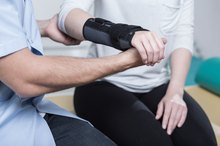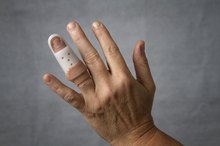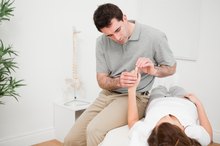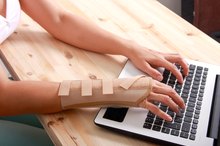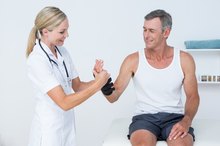Ulnar Variance & Exercise
Your lower arm is made up of two bones -- the ulna and the radius. The length of these bones can lead to an ulnar variance, which can cause wrist pain, degenerative ailments, improper hand and wrist functioning, inflammation and a limited ability to perform everyday activities. Exercise plays a key role in restoring and maintaining your hand and wrist health while lowering the risk of further injuries. As every condition varies, consult with your doctor before starting new exercises.
If you are experiencing serious medical symptoms, seek emergency treatment immediately.
Types
Three types of ulnar variances exist, according to Dr. Philip Blazar 1. A normal or neutral ulnar variance means the surface of your distal ulna and radius are equal. A negative variance occurs when the ulna is shorter than the radius. These two variances respond well to conservative treatments, such as exercise. A positive ulnar variance describes an ulna longer than the radius. Severe stages of positive variance conditions may require wrist arthroscopy to repair tears and ligament injuries. All variance types require flexibility and strengthening exercises to return your hand and wrist to a normal functioning level.
- Three types of ulnar variances exist, according to Dr. Philip Blazar 1.
- A normal or neutral ulnar variance means the surface of your distal ulna and radius are equal.
Carpal Shakes
Wrist Exercises After Surgery
Learn More
Negative ulnar variances commonly result in carpal instability, according to Dr. Blazar 1. Taking breaks throughout the day to perform a variety of carpal tunnel exercises will relieve pressure on your median nerve and reduce symptoms of carpal tunnel syndrome. Through frequent hand and wrist exercise, such as the shaking-hand exercise, you can decrease your chance of needing carpal tunnel surgery. You can perform this exercise while seated or standing. Start with your arms at your sides. Lift your right hand in front of you while bending your elbow. Turn your palm inward and pretend you are shaking someone's hand. Slowly move your lower arm up and down while moving your elbow. Make five up-and-down movements on each side.
- Negative ulnar variances commonly result in carpal instability, according to Dr. Blazar 1.
- Through frequent hand and wrist exercise, such as the shaking-hand exercise, you can decrease your chance of needing carpal tunnel surgery.
Digital Flexing
Positive ulnar variances respond well to using digital exercises while recuperating from surgeries that repair ligaments or shorten ulnas. Digital exercises come in handy as conservative exercises for neutral and negative ulnar variances and as part of a post-op rehab maneuver for positive variances that require ulnar osteotomy. Start doing a solo finger abduction stretch while either standing or sitting upright. Slowly lift your right hand and extend it in front of your body, with your elbow straight and palm facing away from you. Place your left fingers onto your right fingers and gently pull each right finger individually toward your body. Hold each position for 10 seconds before slowly returning to the original position. Relax for 10 seconds and then switch sides.
- Positive ulnar variances respond well to using digital exercises while recuperating from surgeries that repair ligaments or shorten ulnas.
- Digital exercises come in handy as conservative exercises for neutral and negative ulnar variances and as part of a post-op rehab maneuver for positive variances that require ulnar osteotomy.
Additional Points
Ulnar Osteotomy Rehabilitation Protocols
Learn More
Begin your exercise program only after immobilizing your hand and wrist per your doctor's recommendation. Immobilization, such as wearing a splint, plays an essential role in properly healing your injury. Always start your exercises at a low intensity and slow pace. As your wrist flexibility and strength increases, gradually increase your weight and intensity amounts. Always consult a medical professional to ensure you're performing the right exercises for your body.
- Begin your exercise program only after immobilizing your hand and wrist per your doctor's recommendation.
Related Articles
References
- Harvard Medical School Online; Cartilage Complex Tears; Brigham Hospital; Philip Blazar, MD; 2010
- Lleva JMC, Chang KV. Ulnar neuropathy. StatPearls. Updated June 4, 2019.
- Chauhan M, M Das J. Cubital tunnel syndrome. StatPearls. Updated December 11, 2018.
- Aleksenko D, Varacallo M. Guyon canal syndrome. StatPearls. Updated May 5, 2019.
- Shah CM, Calfee RP, Gelberman RH, Goldfarb CA. Outcomes of rigid night splinting and activity modification in the treatment of cubital tunnel syndrome. J Hand Surg Am. 2013;38(6):1125–1130.e1. doi:10.1016/j.jhsa.2013.02.039
- Bednar M, Light T, Bindra R. "Chapter 9. Hand Surgery" In: Current Diagnosis and Treatment in Orthopedics (5th edition). McGraw Hill Professional; 2013.
Writer Bio
Crystal Welch has a 30-year writing history. Her more than 2,000 published works have been included in the health and fitness-related Wellness Directory, Earthdance Press and Higher Source. She is an award-winning writer who teaches whole foods cooking and has written a cookbook series. She operates an HON-code-certified health-related blog with more than 95,000 readers. Welch has a B.B.A. from Eastern Michigan University.
